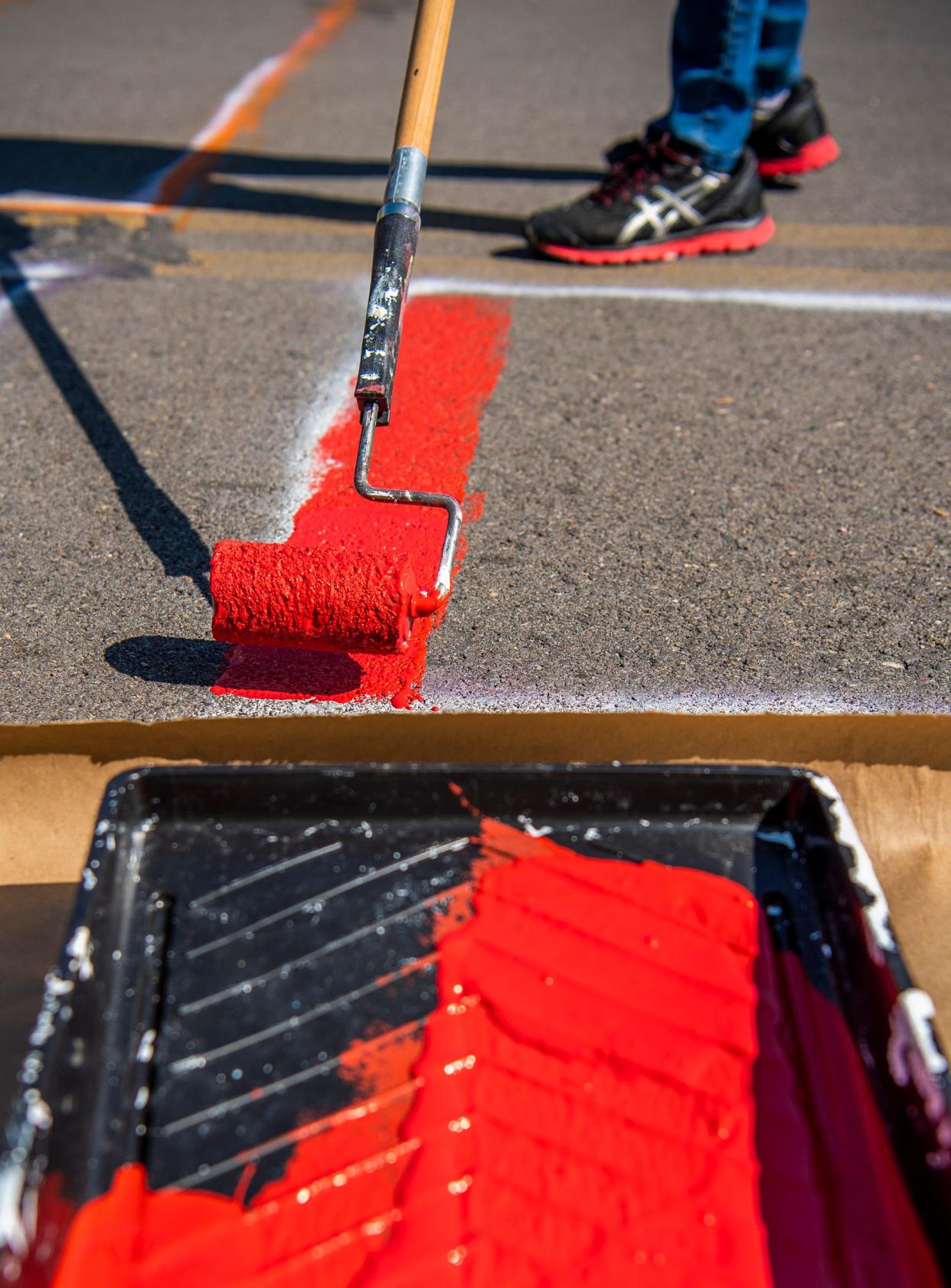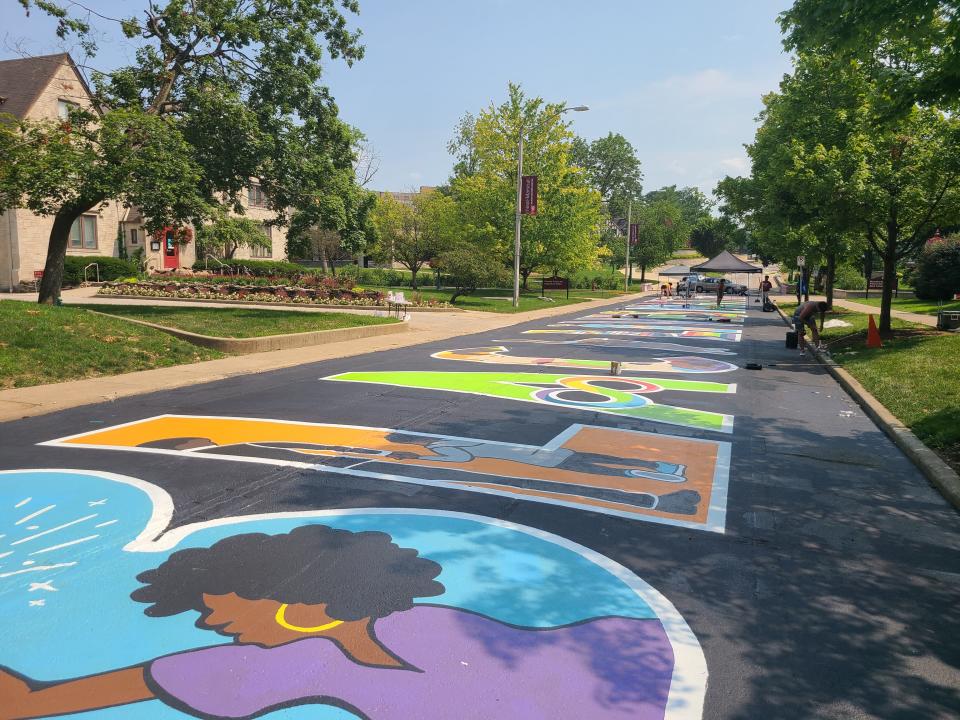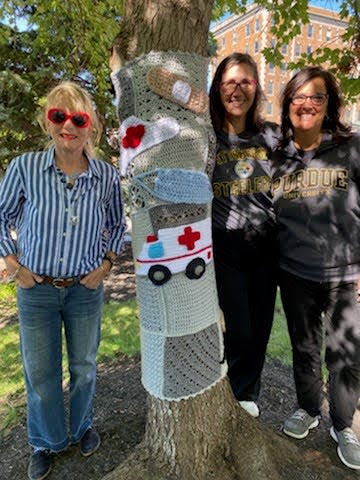Free speech lawsuit spawns new Bloomington city policy, leads to more criticism

Anyone who wants to display public art in Bloomington may have a more difficult time now that a new policy explicitly limits what some artwork can say or depict within the city's right-of-way.
Under Bloomington's court-ordered process, private individuals and groups are given the opportunity to propose an art display within Bloomington's right-of-way, which typically includes streets, alleyways, and sidewalk areas, to the city's board of public works. But in order to get approval, applicants must bow to a slate of restrictions. For example, under the new requirements, art remaining up for more than seven days cannot include any words, numbers or widely known symbols.
While the new policy has been criticized as an attack on free speech, city officials say this is just a formalization of what staff have always done on an informal basis. With the restrictions now officially codified, the policy could impact mainstays of public art that have been part of Bloomington for years.
Why the new rule? IU student's lawsuit alleges discrimination
The new policy was ordered by a judge in late November as part of ongoing ligation between Bloomington and an Indiana University student.
Since early last year, the city has been engaged in a lawsuit over officials' rejection of a street mural proposal, a move the IU student claims is viewpoint discrimination.
In the lawsuit, Kyle Reynolds, president of IU's chapter of Turning Point USA, alleged his First Amendment rights were violated by city personnel within the public works department because they would not approve an "All Lives Matter" mural after previously approving multiple "Black Lives Matter" street paintings.
Ruling:Federal judge says city may have shown bias in 'All Lives Matter' street mural case
Bloomington has three BLM murals — one on North Elm Street next to the Banneker Community Center, another on Sixth Street immediately north of the courthouse and a third on North Eagleson Avenue near IU's Neal-Marshall Black Culture Center.

Reynolds' 15-by-145-foot mural was proposed for East Kirkwood Avenue, in front of the Von Lee building and near IU's iconic Sample Gates. The art would feature the slogan, "All Lives Matter," with thin blue and red lines. The phrase "All Lives Matter" was created in response to the Black Lives Matter movement and is typically associated with conservative views while the thin lines represent support for first responders.
When Reynolds tried to submit his proposal, city personnel said they were not accepting new street art suggestions at that time, the lawsuit alleges. At issue in the ongoing litigation is whether city officials showed viewpoint bias and violated the First Amendment rights of Reynolds and Turning Point USA, which describes itself as seeking to "educate students about the importance of fiscal responsibility, free markets, and limited government."
Who was Edson Sample?IU Sample Gates wouldn't have been built without this man.
In late November, a judge ordered Bloomington officials to disseminate and make widely known "the procedural steps whereby private individuals and groups can seek approval for an encroachment on the City of Bloomington's rights-of-way for the purpose of displaying public art" within 45 days. This means the city cannot deny anyone the opportunity to present their plan for a street mural or other public art project.
One month later, the board of public works adopted the city's policy on private art installations within the public right-of-way.
The judge also ruled the city is prohibited from denying access to or delaying the application process for the All Lives Matter mural, which still requires approval from the city.
New city rules limit speech in public art. Here's how that might affect you.
The new policy doesn't create any more paperwork for the applicants. As they have done in the past, private groups or individuals will still either use the special event application process or the Neighborhood Improvement Grant Program process, which will then be considered by the board of public works. This policy will steer board members' thinking on what should or should not be approved based on explicit criteria. As described by city attorney Mike Rouker, this policy just formalizes the type of review that staff had performed informally.
But the specific written criteria is new. Applications for approval of a semi-permanent or permanent art installation within the right-of-way must include the design's dimensions, accurate depiction to scale, proposed location and the name and qualification of the artist.
Art installations staying up for more than seven days also cannot have speech of any kind, such as words, letters, numbers, universally recognized symbols or logos.
According to Rouker, the policy was written this way in order to mitigate risk to public safety and burden on public resources.
"Anything that is installed in the public right-of-way has the possibility of presenting a conflict with existing traffic control devices and creating a space that is less safe for drivers, cyclists, pedestrians, and other users of the right-of-way. In addition, proposals to install public art require the attention of municipal officials in numerous ways," Rouker wrote in an emailed response.
Reynolds' initial design for the ALM mural does not fair well under this new policy. In a Jan. 3 email, Rouker acknowledged receiving Reynolds' proposal and provided some notes for certain proposed elements to be modified in order to meet the new policy standard.
Since a street mural is classified as a permanent art installation, it cannot have speech such as "All Lives Matter." In his proposal, Reynolds must also include the identity and qualifications of the mural's artist, specification of painting materials, a scaled drawing and other documents. In the email, Rouker noted the city is still reviewing his application.

Something the new policy doesn't cover? The BLM murals. These are classified as government speech. Under the government speech doctrine, a government has its own rights as a speaker, where it can assert its own ideas and messages without being subject to claims of viewpoint discrimination. A city can decide what messages to adopt and which ones to reject. The BLM murals were painted on city-owned streets with that message being expressed by the city itself, so they are not considered private art installations. This claim was affirmed by the judge in the ongoing litigation.

But the policy may have wider implications for other art mainstays. It could impact Middle Way House's annual "Wrapped in Love" display, which decorates city trees in sweaters, typically with words and symbols, to raise awareness about domestic violence and support resources. Rouker said the city has reached out to Middle Way House to talk about how this policy may apply to them and "are happy to do the same with others regarding their projects."
Critics say the policy limits free speech. Bloomington disagrees.
During the Board of Public Works' Dec. 20 meeting, Thomas Westgard spoke during the public comment portion to raise concerns over the new policy's language, specifically its prohibition of speech on permanent and semi-permanent art.
Westgard takes issue with speech's definition, which includes universally recognized symbols. According to Westgard, that definition is too broad and can be exploited.
"At best, you're inviting litigation," Westgard said at the meeting.
He gave an example of a mainstream Christian group wanting to place a sign in the right-of-way with a cross on it. It would be rejected since that is a universally known symbol. However, if an obscure religion comes up with a new symbol and wants to place it on the right-of-way, it could potentially pass.
"What this does on its face is it says well-known symbols are disallowed (and) lesser known symbols are allowed. That is a content-based restriction," Westgard said.
Reynolds, the IU student, sent the following email statement when reached for comment.
"We continue to believe that Bloomington has created a public forum by allowing private groups to paint murals on city streets. We have a right to participate in that forum, the same as any other group or individual. We disagree with the city's past and recent efforts to restrict access to this forum and will continue to work through the proper channels to ensure that our rights and the rights of other Bloomington residents are protected," Reynolds wrote.
Rouker argues this policy leaves plenty of room for free speech because the policy only applies to private art installations in the public right-of-way. This leaves opportunity for installations on other public and private property.
This policy does not forbid speech for all private art installations either; those that are up for seven days or less, such as ice sculptures created during the upcoming FreezeFest, can contain speech.
"[A]rt installations are merely one form of speech. Notably, the policy doesn’t apply at all to performative art, and as always, the public may engage in other forms of speech in the right-of-way," Rouker said.
Reach Rachel Smith at rksmith@heraldt.com.
This article originally appeared on The Herald-Times: Bloomington limits speech in art installations in public right of way

